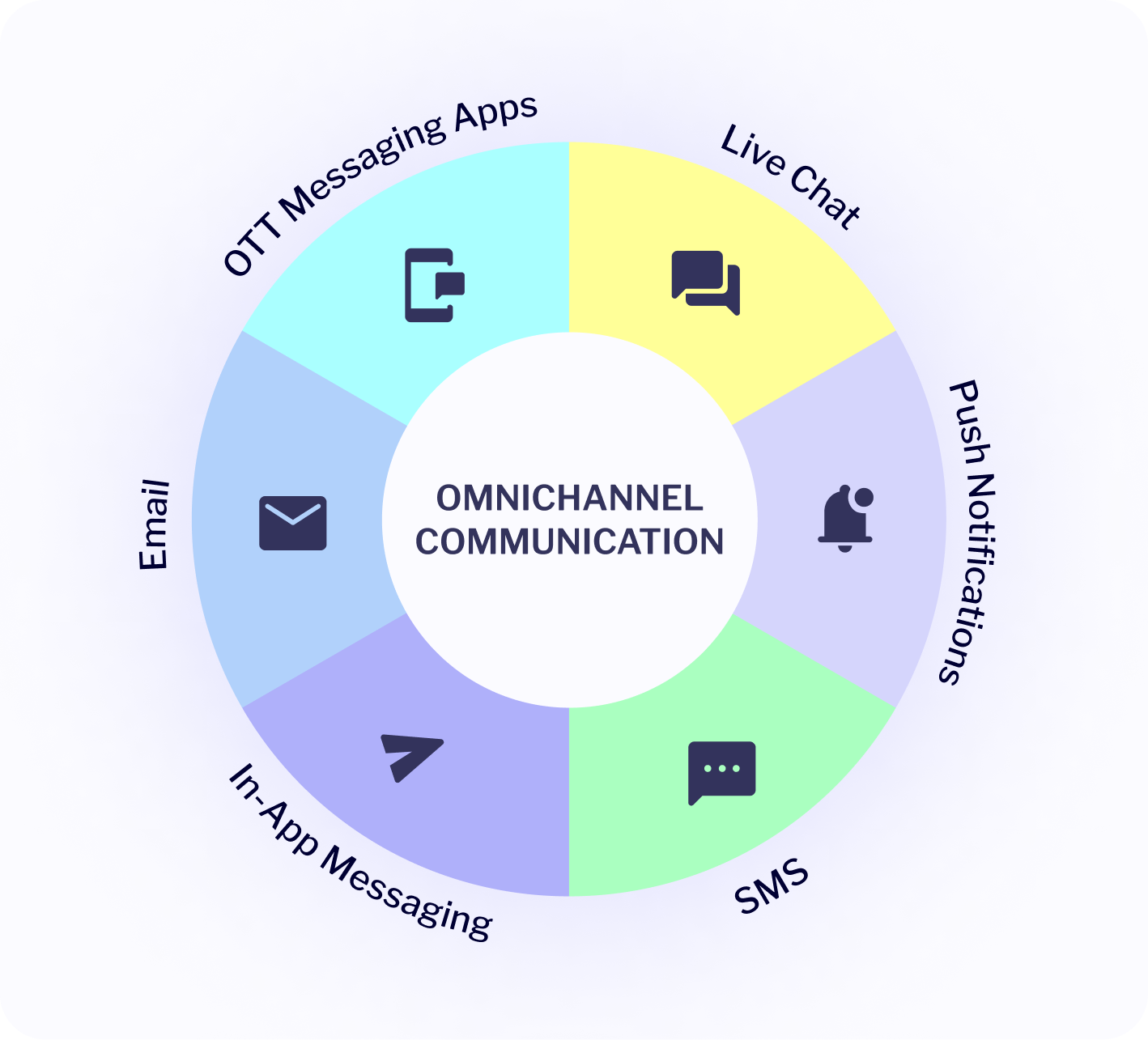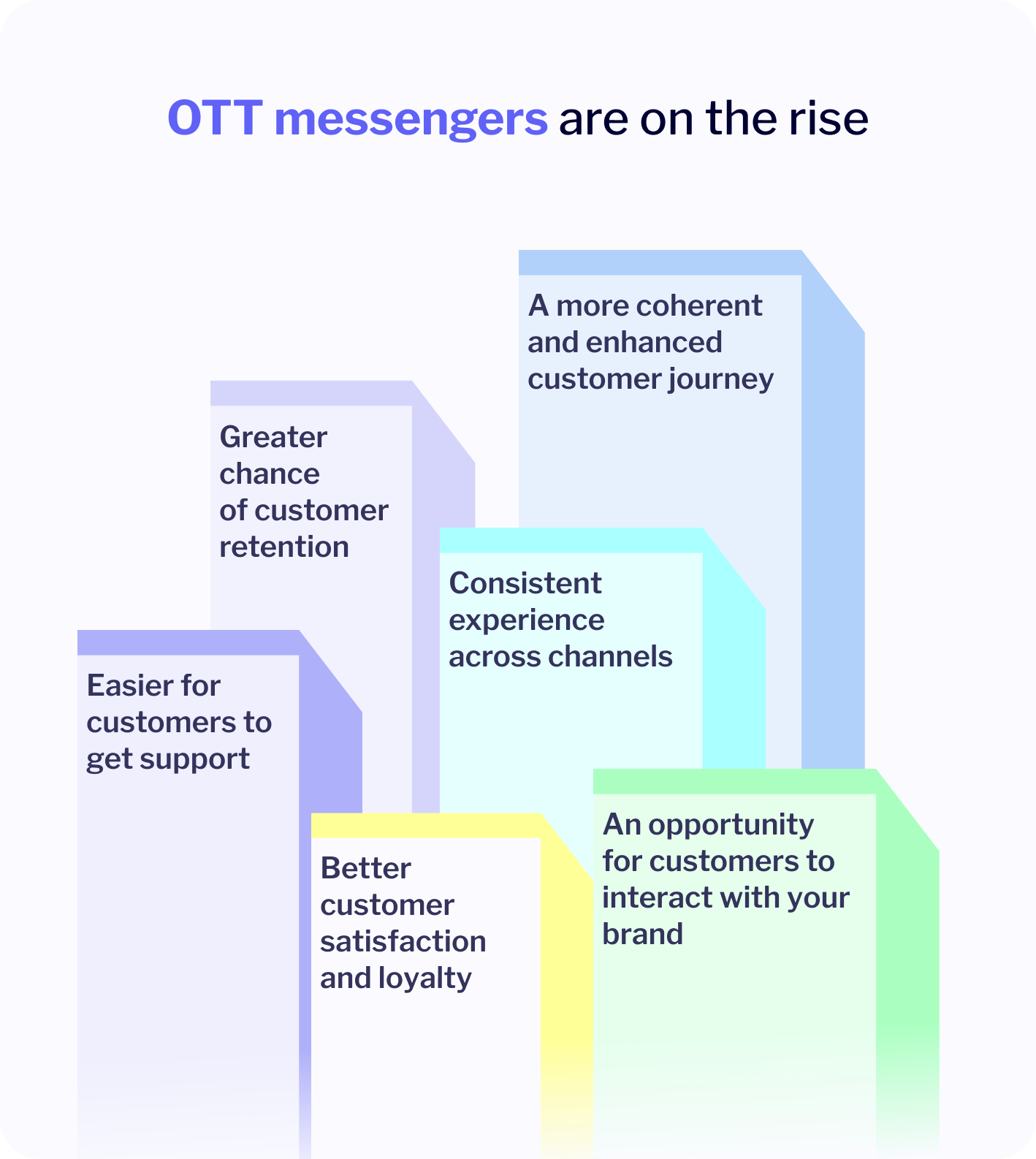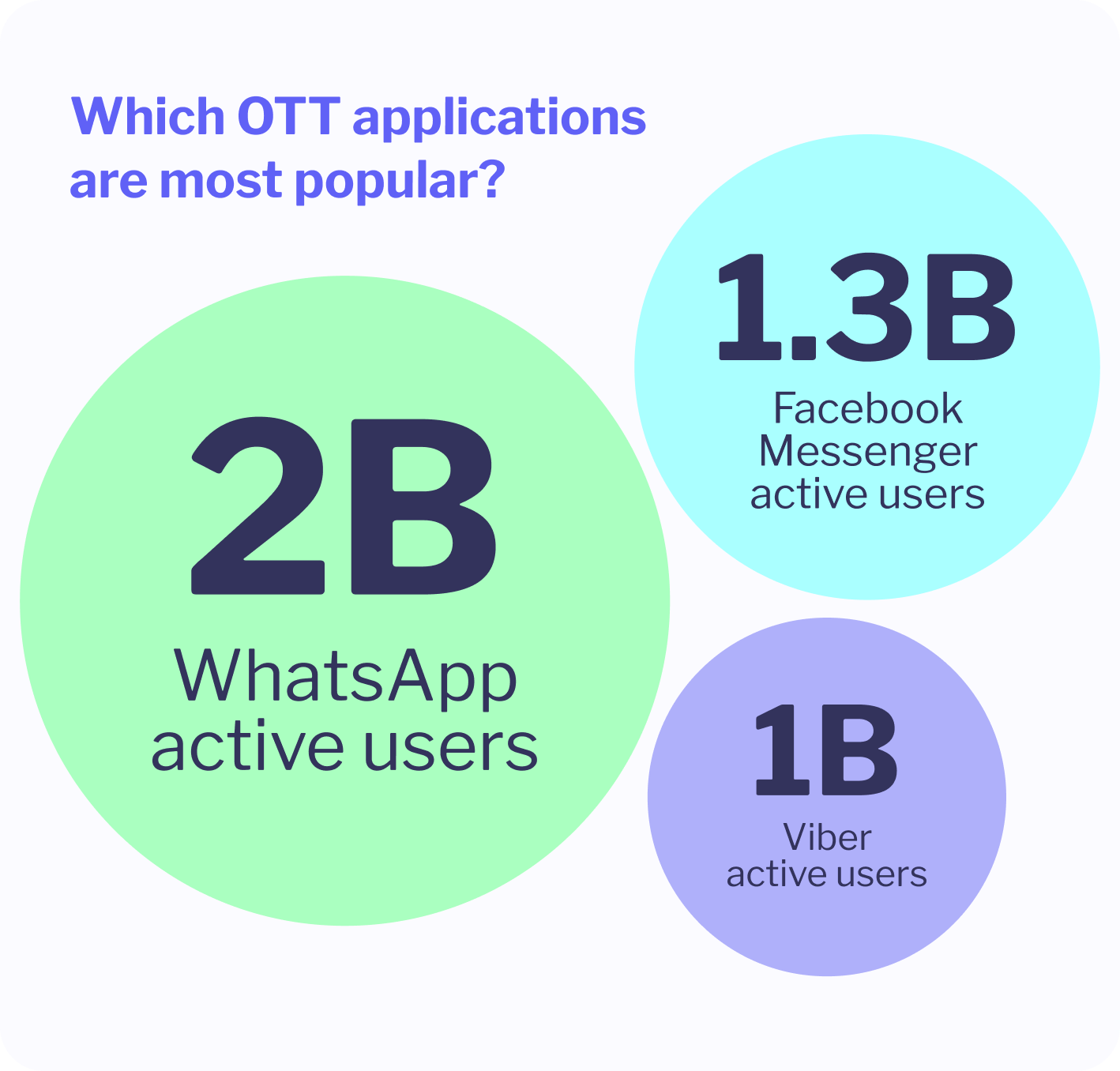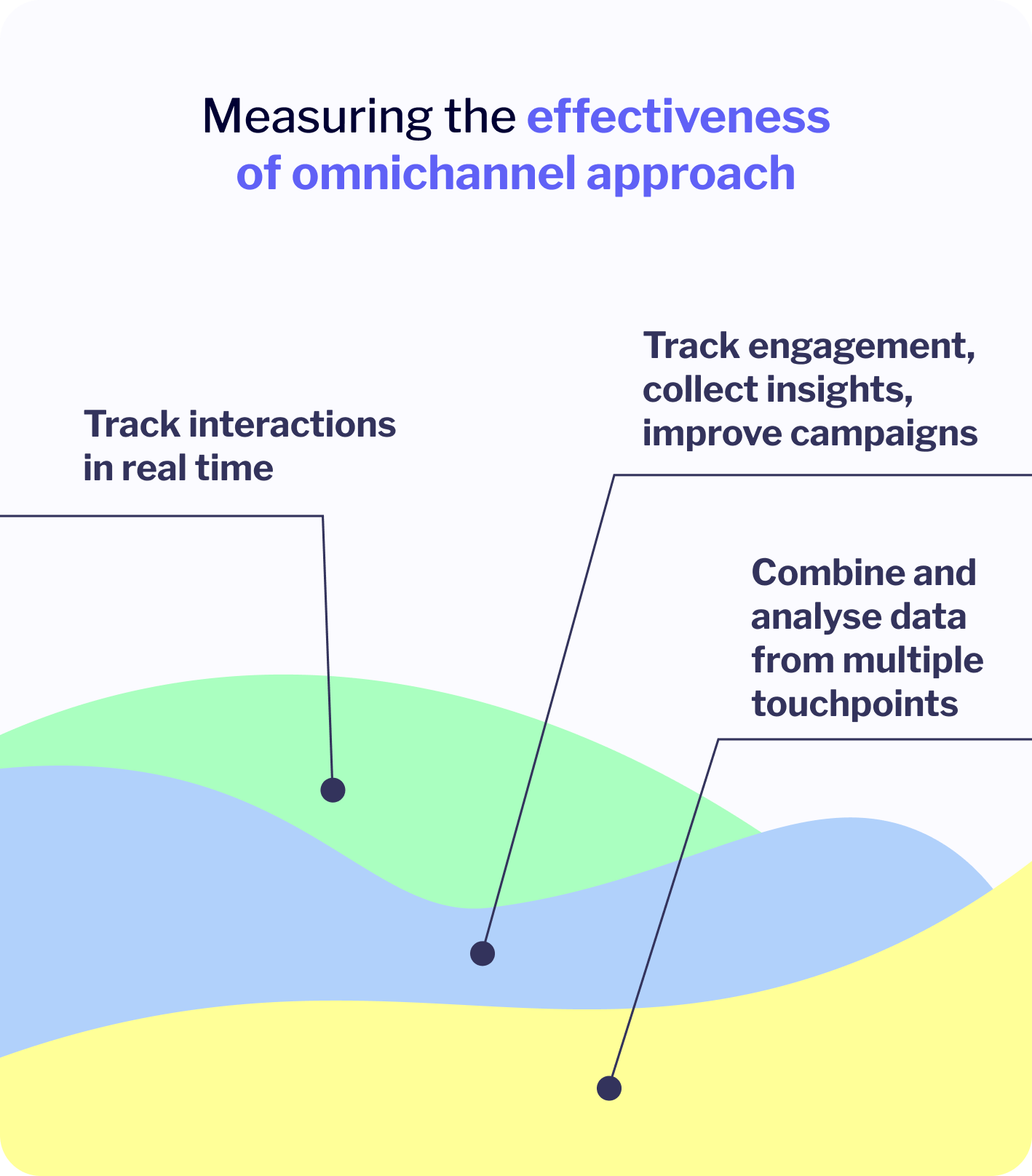Not long ago, businesses decided where and how customers could reach them, relying on established marketing channels like email and sticking to one or two options at most. But times have changed. The modern online environment demands flexibility.
Did you know that 72% of consumers prefer engaging with brands across multiple channels for a seamless experience? Modern customers want the power to choose where and when they interact with brands, forcing businesses to adapt by being present at every stage of the customer journey. For marketing teams, this means asking: Where is our audience? What’s the best way to reach it in 2025 and beyond?
While there’s no one-size-fits-all answer, an omnichannel communication strategy is one of the ways forward. And within it, OTT messaging applications like WhatsApp and Viber deserve special attention. Once flying under the radar, they’re now key to providing a truly cohesive and customer-first service. Let’s take a closer look at how they fit into a broader omnichannel experience!
Defining an omnichannel communication strategy
Omnichannel communication is a marketing strategy where you create an integrated customer experience across multiple platforms. Often involving both online and offline channels, it adapts to customer preferences at every touchpoint.
Whether it’s mobile push notifications, SMS messages, or RCS communication, the goal is to meet your audience where they are and provide them with a consistent brand experience.

While omnichannel strategies aren’t confined to specific channels, this article focuses on their digital side, from SMS marketing to the increasingly powerful OTT messaging applications. More on them in just a moment.
Benefits of using an omnichannel approach
An omnichannel approach to communication offers several advantages in terms of how customers engage with a brand. The most notable ones out of the bunch include higher customer satisfaction and a greater chance of customer retention. Here’s a more detailed list!
- Coherent and enhanced customer journey.
By linking different touchpoints, you create a seamless journey that feels natural to the customer, guiding them effortlessly from discovery to purchase. - Better customer satisfaction and loyalty.
When customers can interact with your brand on their preferred channels, they feel valued, which strengthens their trust and loyalty. - Consistent experience across channels.
Consistency in branding, tone, and support ensures that your business leaves a positive impression, regardless of how or where customers interact with you. - Greater chance of customer retention.
Customers are more likely to return when they experience smooth and personalised interactions across different channels. - Opportunity for customers to interact with your brand.
An omnichannel approach ensures your brand is visible and accessible wherever your customers spend their time, fostering stronger relationships. - Easier for customers to get support.
Customers appreciate being able to reach out for help using their preferred channels, which reduces frustration and enhances their overall experience.

What are OTT messaging apps?
OTT (over-the-top) messaging applications, such as Viber and WhatsApp, are platforms that allow users to exchange messages and media, as well as make calls over the internet, bypassing traditional SMS services.
These apps have become a staple in global communication, with WhatsApp boasting over 2 billion active users and Facebook Messenger reaching 1.3 billion users worldwide. Viber, another key player, has a significant presence in Europe and Asia with over 1 billion users globally.

For businesses, OTT messengers represent a powerful tool for building connections with customers. They offer features such as media-rich communication, one-on-one conversations, and group chat capabilities, all within the platforms customers are already using daily.
From personalised promotions to real-time customer support, OTT messaging applications can be neatly mixed into any omnichannel marketing strategy. For example, Viber business messaging allows you to send interactive, engaging marketing messages to its extensive, global user base.
Making OTT messengers a part of an omnichannel strategy
OTT messaging applications have become key tools in an omnichannel approach. They allow you to connect with customers on their favourite messaging platforms, which is where they spend much of their time. These applications excel at creating personalised, real-time interactions that feel authentic and engaging.
Their rich media capabilities, like sharing images, videos, and other interactive content, make communication more dynamic and memorable. By integrating OTT messengers with other channels like email and SMS, you ensure a consistent and seamless customer experience across different touchpoints.
Incorporating OTT messengers into a customer communication strategy is about meeting customer expectations for convenience, immediacy, and personalisation. It’s a step toward building stronger relationships and enhancing overall customer engagement and satisfaction.
Top 5 reasons why OTT messengers should be a part of any omnichannel marketing strategy
You may be wondering: “Are OTT messaging applications really worth adding to my communication strategy?” The answer is a resounding yes!
These platforms are not just excellent supplementary channels. They fill in the gaps in a direct, interactive, and highly engaging manner.
OTT messengers thrive on dynamic, two-way communication. Whether it’s casual conversational messaging, sharing files and images, or adding interactive elements like buttons and polls, they help keep engagement levels high. Their less formal tone also resonates well with customers, making brands feel more approachable and human.
When combined with mobile marketing efforts, OTT messengers can significantly enhance any marketing strategy and boost conversions. Here’s why they work so well.
- Personalised and targeted messaging.
OTT applications allow you to craft messages tailored to individual customers, leveraging data like past purchases, preferences, and behaviour. It builds trust and improves the likelihood of conversion. - Real-time, interactive engagement.
Customers value instant responses, and OTT applications deliver. Be it through live chat or quick reply buttons, these platforms make communication smooth and interactive, which encourages customers to take action. - Rich media capabilities.
OTT messengers support engaging content like videos, audio files, and clickable buttons. This visual and interactive appeal is bound to increase click-through rates. - Broader reach with high engagement rates.
With billions of active users globally, platforms like WhatsApp and Viber give you access to a massive audience. Moreover, messaging applications tend to have high open and response rates, making them incredibly effective for engagement. - Building long-term relationships
Two-way communication creates meaningful customer interactions across channels that go beyond a one-off campaign. As a result, OTT messengers can help you nurture ongoing relationships with clients, fostering loyalty and repeat purchases.
Implementing OTT messaging in a successful omnichannel communication strategy
With many different communication channels available, the key to success doesn’t lie in being present on as many channels as possible. It lies in strategically integrating them into the broader customer journey map. Each channel has its strengths and works best in specific scenarios. Below, we will explore three practical examples of how OTT messaging can help enhance any omnichannel marketing strategy.
Sending personalised order updates and delivery notifications
Imagine an online retailer that uses WhatsApp to keep customers informed about their purchases. After placing an order, a customer receives real-time updates via WhatsApp, such as order confirmations, estimated delivery times, and even live tracking information.
This approach offers convenience and keeps the customer engaged throughout the post-purchase journey. By adding a conversational element like the ability to chat directly with customer support for delivery questions, you build trust and loyalty.
Running exclusive flash sales or promotions
A clothing brand integrates Viber business messaging into its omnichannel marketing strategy to promote a flash sale. Customers who opt into their Viber updates receive an exclusive, time-limited offer through a rich media message. The message includes visuals of featured products, a countdown timer, and a call-to-action button.
The immediacy and visual appeal of the message drive faster decision-making. At the same time, the conversational nature of Viber allows customers to ask questions or get recommendations before completing their purchase.
Providing seamless customer support for travel services
A banking institution leverages Facebook Messenger to offer instant support. They respond to both basic questions on different banking solutions and requests for account modifications. In such a scenario, Messenger ensures a continuous, two-way dialogue.
Follow-up messages can include personalised financial tips, insights, and product recommendations based on clients’ transaction histories and preferences. Such tailored communications foster long-term customer relationships.
Measuring the effectiveness of an omnichannel approach involving instant messaging
An omnichannel strategy thrives on engagement. If you’re a marketer, you will need to keep a close eye on this metric. Luckily, OTT messengers provide the tools you need to track engagement, collect actionable insights, and create marketing campaigns that speak to your audience.
For instance, platforms like WhatsApp and Viber allow you to track interactions in real time, such as read receipts, link clicks, and responses to interactive elements like buttons or polls. These metrics offer deeper insights into customer behaviour, helping you understand not just if your message was delivered but how it was received and acted upon.

Drive conversions with a successful omnichannel strategy
An effective omnichannel communication strategy is about more than just using multiple channels. The objective is to create a unified, seamless experience that meets your customers where they are. With their real-time engagement, rich media capabilities, and detailed metrics, OTT messaging applications will help you achieve that goal with ease. As a result, you will get to boost engagement rates,drive conversions, and, ultimately, achieve better results.
Business communication made easy with MessageFlow
If you’re ready to take advantage of business communication, MessageFlow has everything you need to get started! Our platform allows you to deliver a consistent customer experience with ease.
With MessageFlow, you can do a bunch of useful things.
- Ensure GDPR and ISO compliance for large-scale messaging campaigns.
- Set up marketing campaigns quickly with the help of our intuitive dashboard.
- Expand business operations locally or globally.